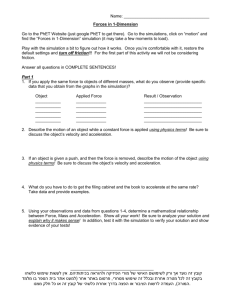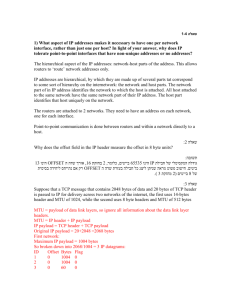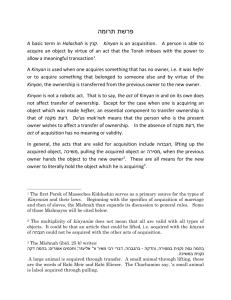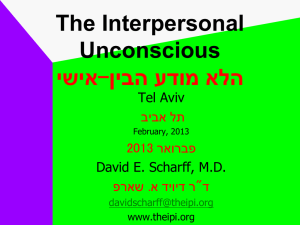Tirgul07_OPM_Mt
advertisement
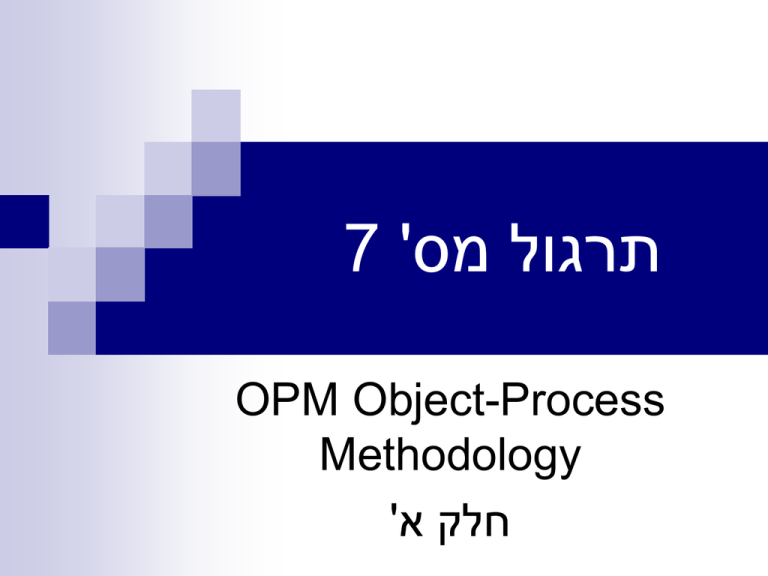
7 'תרגול מס OPM Object-Process Methodology 'חלק א What is OPM? A comprehensive system modeling, engineering and lifecycle support paradigm. Describe the system structure and behavior. OPM tutorial 1 Analysis of Information Systems 2 OPM Bi-modal Representation A single diagramming tool: Object-Process Diagram (OPD) A corresponding subset of language: Object-Process Language (OPL) OPM tutorial 1 Analysis of Information Systems 3 OPM Modeling Environment OPCAT is the Object Process CASE Tool OPD Tree Object-Process Diagram (OPD) Object-Process Language (OPL) OPM tutorial 1 Analysis of Information Systems 4 OPM Elements: Entities and Links Entity types: Object: A thing that exists for some time State: A situation at which an object can be Process: A thing that transforms an object Link types: Structural link: A link denoting a persistent relation between objects Procedural link: A link between a process and orSystems a state of that object Analysis of Information OPM tutorial 1 the object it transforms 5 OPM: Combining Function and Structure OBJECT LINKS A thing that exists Procedural OPD PROCESS A thing that transforms objects Structural OPL STATE Describes the Object’s situation OPM tutorial 1 Analysis of Information Systems 6 OPM Structural Links Links denoting persistent relations between objects Fundamental: Aggregation-participation Exhibition-characterization Generalization-specialization Classification-instantiation General: Unidirectional tagged structural relation Bidirectional tagged structural relation OPM tutorial 1 Analysis of Information Systems 7 Aggregation-participation A structural relation between the whole and its parts OPM tutorial 1 Analysis of Information Systems 8 Participation constraints The aggregation-participation link can have participation constraints on the parts OPM tutorial 1 Analysis of Information Systems 9 Exhibition-characterization A structural relation between a thing and its features OPM tutorial 1 Analysis of Information Systems 10 Generalization-specialization A structural relation between a thing and its specializations (known as the “is-a” relation) OPM tutorial 1 Analysis of Information Systems 11 Classification-instantiation A structural relation between a thing and its instances OPM tutorial 1 Analysis of Information Systems 12 General tagged structural link A structural relation between two things whose semantics is expressed through its tag Bidirectional tagged structural link Unidirectional tagged structural link OPM tutorial 1 Analysis of Information Systems 13 Participation constraints Structural relation can be associated with various quantities OPM tutorial 1 Analysis of Information Systems 14 Procedural Links Links denoting how processes relate to objects Enabling Links Transforming Links OPM tutorial 1 Agent link Instrument link Result/Consumption (input/output) link Effect link Analysis of Information Systems 15 Agent Link Links a human or a group of humans that trigger the process or participate in it OPM tutorial 1 Analysis of Information Systems 16 Instrument Link Links a non-human object that the process requires in order for it to occur or execute OPM tutorial 1 Analysis of Information Systems 17 Result link Object does not exist before the process starts OPM tutorial 1 Analysis of Information Systems 18 Consumption link Object does not exist when the process ends OPM tutorial 1 Analysis of Information Systems 19 A process changes an object’s state OPM tutorial 1 Analysis of Information Systems 20 An OPM modeling exercise Exercise: What is word processing? The editor uses a word processor in order to convert the content of a document from raw text to properly edited material. Modeling Steps: Who/what is involved? The edited document and the editor What are the main processes? Word processing Inputs and outputs Document’s text What are the transformations? Document’s raw text becomes edited What are the information elements? Document’s text OPM tutorial 1 Analysis of Information Systems 21 An OPM modeling exercise (cont.) OPM tutorial 1 Analysis of Information Systems 22 תרגיל כיתה משה החליט לקנות עוגת שוקולד בקונדיטוריית "טוב וטעים" .עפ"י המתכון המפקחת חני הכינה את הבצק )לצורך זה היא הייתה זקוקה ל 3-ביצים ,קמח, סוכר ,מרגרינה ,אבקת אפיה וקקאו( והכניסה אותו לתנור .בזמן האפייה עפ"י המתכון היא והעובדת דקלה הכינו את ציפוי השוקולד )המצרכים הדרושים הם2 : חבילות שוקולד ומרגרינה(. כשהעוגה והציפוי היו מוכנים ,חני הוציאה את העוגה מהתנור ויחד עם דקלה שמה את הציפוי שוקולד .לבסוף דקלה קישטה את העוגה עם סוכריות צבעוניות. Modeling Steps: ? Who/what is involved חני ,דקלה ? What are the main processes הכנת בצק ,אפייה ,הכנת ציפוי ,ציפוי העוגה ,קישוט העוגה Inputs and outputs חומרי גלם לבצק ,בצק ,עוגה ,חומרי גלם לציפוי ,ציפוי ,סוכריות ?What are the transformations ח"ג הופכים לבצק ,בצק הופך לעוגה ,ח"ג הופכים לציפוי מתכון ? What are the information elements 23 Analysis of Information Systems OPM tutorial 1 פתרון תרגיל כיתה .1המפקחת חני הכינה את הבצק 24 .2והכניסה אותו לתנור Analysis of Information Systems OPM tutorial 1 פתרון תרגיל כיתה )המשך( .3בזמן האפייה היא והעובדת דקלה הכינו את ציפוי השוקולד 25 Analysis of Information Systems OPM tutorial 1 פתרון תרגיל כיתה )המשך( .4כשהעוגה והציפוי היו מוכנים ,חני הוציאה את העוגה מהתנור ויחד עם דקלה שמה את הציפוי שוקולד. 26 Analysis of Information Systems OPM tutorial 1 פתרון תרגיל כיתה )המשך( .5לבסוף דקלה קישטה את העוגה עם סוכריות צבעוניות 27 Analysis of Information Systems OPM tutorial 1 תרגיל כיתה נוסף חברת "עיניים לשמיים" מוכרת משקפי ראיה בהתאם לנתוני לקוח. לחברה לקוחות קבועים ולקוחות ארעיים. כאשר לקוח קבוע מגיע לחברה עליו: .1לפנות למוכר אשר שולף את טופס הלקוח המתאים לפי מספר לקוח ממערכת "מיאינפו" על מנת להציג ללקוח משקפיים רצויים. כאשר לקוח ארעי מגיע לחברה עליו: .1להיבדק ע"י אופטמטירס – לאחר ביצוע הבדיקה ע"י מכשיר הנקרא "בדקעין" האופטמטירסט ממלא פרטי מספר והאם קיים צילינדר )כולל גודל( עבור כל עין בטופס לקוח במערכת )בשלב זה הלקוח הופך ללקוח קבוע( .2לפנות למוכר על מנת להזין לטופס לקוח את נתוני משקפיים הרצויים הבאים :סוג מסגרת )שלם ,חצי ,ללא( ,צורת מסגרת רצויה )עגול ,אליפטי ,מרובע( ,עובי מסגרת וצבע מסגרת. ולבסוף בחירת משקפיים רצויות מתוך מבחר המשקפיים המוצגות לפניו ע"י המוכר. 28 Analysis of Information Systems OPM tutorial 1 פתרון תרגיל כיתה נוסף OPM tutorial 1 Analysis of Information Systems 29
